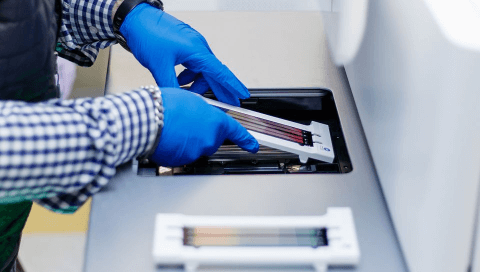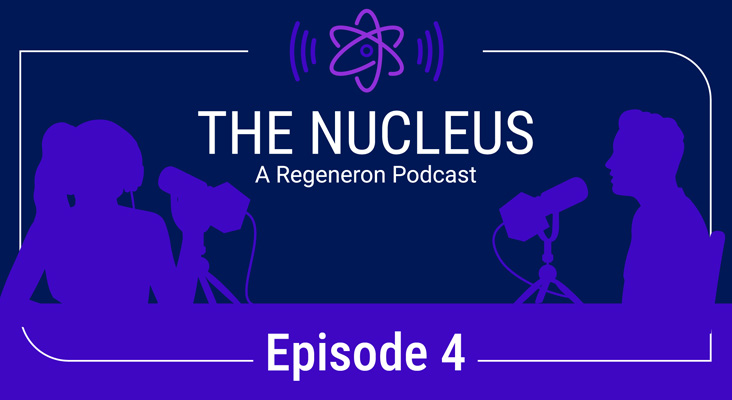Genetics
A New Breakthrough in the Search for Protective Genetics – and the Medicines That Mimic Them
July 06, 2021
Learn more about protective genetic variants and the Regeneron Genetics Center's discovery of the GPR75 protective gene associated with reduced body weight and obesity risk.
By: Aris Baras, MD, Senior Vice President and Head of the Regeneron Genetics Center®

Whether Alan Turing and the British code breakers at Bletchley Park or “The Code Girls,” 10,000 courageous women who served the US military as cryptographers during World War II, the stories of code breakers have captivated our imagination through feats of intellectual brilliance, cutting-edge technology and dogged persistence. More recently, a new breed of code breakers has emerged: the scientists and technologists cracking the code of the human genome in pursuit of something bigger – cures for as many diseases as possible, with the potential to save millions, if not billions, of lives.
The Regeneron Genetics Center® proudly announced the discovery of protective GPR75 genetic variants associated with reduced body weight and obesity risk. This breakthrough – the latest “superpower” uncovered in the genetic code – could reshape how we address obesity, which affects 650 million people globally1.
Protective variants as superpowers
For two decades, geneticists have made progress cracking the code of health and disease, not only by identifying gene variants, or mutations, that cause disease – such as with cystic fibrosis and sickle cell anemia – but also by discovering variants that protect from disease. Rare individuals have been identified who have protection from certain diseases and whose superpowers lie within their genes. These discoveries have become the holy grail in genetics research, launching efforts to develop therapeutics that mimic their impact.
One of the first discoveries of protective genetics was resistance to HIV infection. HIV, a virus that attacks white blood cells and can lead to immunodeficiency, was often fatal prior to the development of anti-retroviral therapies. In the 1990s, scientists discovered that some people were protected because they had a certain rare variant: deletions of the CCR5 gene meant that these people didn’t have a receptor on white blood cells that many HIV strains needed to latch on to2 .This led to the invention of CCR5 inhibitors, medicines that mimic the protective effects of CCR5 genetic deletions and block HIV infection.
In the early 2000s, geneticists discovered individuals with variants of the PCSK9 gene that conferred cardio-protection, resulting in significantly lower rates of heart attacks3. Several companies, including Regeneron, developed PCSK9 inhibitors that modeled this protective effect and reduce high cholesterol and heart disease.
Searching for superpowers
We’ve made many other similar discoveries since launching RGC in 2013 to accelerate the journey from genetic discovery to impactful therapeutics. We’ve sequenced the exomes or genomes of nearly 1.5 million consented participants in global research studies, leading to exciting new findings:
- We and our collaborators uncovered protective variants in the ANGPTL4 gene that reduce risk of heart disease and diabetes and in ANGPTL3, a related gene, that also reduce heart disease risk4. These discoveries supported development of Regeneron’s ANGPTL3 antibody, which recently became the first such drug approved by the FDA for cholesterol disorders and heart disease5.
- We and others discovered protective variants in the IL33 gene that reduce risk of asthma and chronic obstructive pulmonary disease (COPD). Regeneron has now advanced our IL33 antibody into late-stage clinical development for both diseases6.
- Most recently, we uncovered the first protective genetic variant for chronic liver diseases, including non-alcoholic fatty liver disease for which there is no treatment. Individuals with loss of function variants in the HSD17B13 gene have protection from many forms of chronic liver diseases, and we are partnering with Alnylam on development of a clinical-stage RNA interference therapeutic targeting this gene7.
Introducing GPR75
Today we add to this list of exciting discoveries. Our data published today in Science pinpoints the protective gene, GPR75, as a new therapeutic target for healthy leanness. By analyzing genetic sequence, body weight and obesity in nearly 650,000 individuals, RGC, Geisinger, Oxford and National Autonomous University of Mexico (UNAM) scientists uncovered protective variants in GPR75. These rare individuals – approximately 1 in 3,000 – have about 12 pounds lower body weight and 54% lower risk of obesity, meaning they have the superpower of leanness and resistance to obesity8. The gene encodes a G-protein coupled receptor, or GPCR. The extra good news is that GPCR targets are already know to be a “targetable” class of genes and proteins, meaning there are existing medicines that use GPCRs as a drug target, giving us higher odds of success for future therapeutics.
We’ve already begun drug discovery efforts for GPR75 and are committed to translating this discovery into new medicines for patients struggling with obesity. We have experienced partners who bring the most cutting-edge genetic technologies into our arsenal of approaches. We have high hopes for success in this latest in a long line of protective genetics discoveries that have fueled new therapeutics programs at Regeneron.
Our search for genetic superpowers continues. Three billion letters make up the human genome and represent the code of human health. The search for protective genetics is one of the great scientific explorations of our time, and the ultimate code to crack.
Thank you to the dedicated scientists who’ve made these discoveries possible, to collaborators at medical centers and health systems around the world, and, most importantly, to the millions of volunteers worldwide who participated in these studies; without you, none of this would be possible.
References
- “Obesity and Overweight,” World Health Organization, June 9, 2021, https://www.who.int/news-room/fact- sheets/detail/obesity-and-overweight.
- “Homozygous Defect in HIV-1 Coreceptor Accounts for Resistance of Some Multiply-Exposed Individuals to HIV-1 Infection,” Cell Press Online, August 9, 1996, https://www.cell.com/cell/fulltext/S00928674(00)801105?%20_returnURL=https%3A%2F%2Flinkinghub.elsevier.com%2Fretrieve%2Fpii%2FS0092867400801105%20%3Fshowall%253%20Dtrue
- “Low LDL cholesterol in individuals of African descent resulting from frequent nonsense mutations in PCSK9,” National Library of Medicine, February 2005, https://pubmed.ncbi.nlm.nih.gov/15654334/.
- “Regeneron Genetics Center Publication in New England Journal of Medicine Links ANGPTL4 Inhibition and Risk of Coronary Artery Disease,” Regeneron, March 2, 2016, https://investor.regeneron.com/news-releases/news- release-details/regeneron-genetics-center-publication-new-england-journal?releaseid=958547.
- “FDA Approves First-in-Class Evkeeza (EVINACUMAB-DGNB) For Patients With Ultra-Rate Inherited Form of High Cholesterol,” Regeneron, February 11, 2021, https://investor.regeneron.com/news-releases/news-release-details/ fda-approves-first-class-evkeezatm-evinacumab-dgnb-patients
- “Regeneron and Sanofi Announce Positive Topline Phase 2 Results For IL-22 Antibody in Asthma,” Regeneron, June 21, 2019, https://newsroom.regeneron.com/news-releases/news-release-details/regeneron-and-sanofi- announce-positive-topline-phase-2-results.
- “Regeneron and Alnylam Announce Broad Collaboration to Discover, Develop and Commercialize RNAi Therapeutics Focused on Ocular and Central Nervous System (CNS) Diseases,” Regeneron, April 8, 2019, https://investor.regeneron.com/news-releases/news-release-details/regeneron-and-alnylam-announce-broad-collaboration-discover.
- P. Akbari, A. Gilani, O. Sosina et al., Science 373, eabf8683 (2021). DOI: 10.1126/science.abf8683
Last updated: December 2024
More Regeneron Stories


